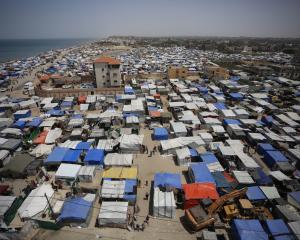China's increasing military presence in the disputed sea could effectively lead to a Beijing-controlled air defence zone, they said, ratcheting up tensions with other claimants and with the United States in one of the world's most volatile areas.
Chinese foreign ministry officials confirmed on Saturday that a test flight by a civilian plane landed on an artificial island built in the Spratlys, the first time Beijing has used a runway in the area.
Vietnam launched a formal diplomatic protest while Philippines Foreign Ministry spokesman Charles Jose said Manila was planning to do the same. Both have claims to the area that overlap with China.
"That's the fear, that China will be able take control of the South China Sea and it will affect the freedom of navigation and freedom of overflight," Jose told reporters.
China has been building runways on the artificial islands for over a year, and the plane's landing was not a surprise, although it will almost certainly increase tensions.
The runway at the Fiery Cross Reef is 3000m long and is one of three China was constructing on artificial islands built up from seven reefs and atolls in the Spratlys archipelago.
The runways would be long enough to handle long-range bombers and transport craft as well as China's best jet fighters, giving them a presence deep into the maritime heart of Southeast Asia that they have lacked until now.
Work is well under way to complete a range of port, storage and personnel facilities on the new islands, US and regional officials have said.
Fiery Cross is also expected to house advanced early warning radars and military communications facilities, they said.
Chinese officials have repeatedly stressed that the new islands would be mostly for civilian use, such as coast guard activity and fishing research.
Foreign ministry spokeswoman Hua Chunying said at the weekend that the test flight was intended to check whether the runway met civilian aviation standards and fell "completely within China's sovereignty".
Leszek Buszynski, a visiting fellow at the Australian National University's Strategic and Defence Studies Centre, said he believed military landings on the islands were now "inevitable".
An air defence zone, while unlikely soon, was feasible and possible in future once China's built up its air strength.
"The next step will be, once they've tested it with several flights, they will bring down some of their fighter air power - SU-27s and SU-33's - and they will station them there permanently. That's what they're likely to do."
De facto defence zone
Ian Storey, a South China Sea expert at Singapore's ISEAS Yusof Ishak Institute, said he expected tensions to worsen as China used its new facilities to project power deeper into the South China Sea.
Even if China stopped short of formally declaring an Air Defence Identification Zone, known as an ADIZ, Beijing's need to protect its new airstrips and other facilities could see it effectively operating one.
"As these facilities become operational, Chinese warnings to both military and civilian aircraft will become routine," Storey said.
"These events are a precursor to an ADIZ, or an undeclared but de facto ADIZ, and one has to expect tensions to rise."
Hua, the Chinese foreign ministry spokeswoman, said on Monday that there were no immediate plans for an ADIZ in the South China Sea.
"As for whether China will establish an ADIZ, the decision will be based on our judgment of the situation and our needs," she aid, adding that Beijing respected other nations' rights to international freedoms of navigation and overflight.
China claims most of the South China Sea, through which more than $5 trillion of world trade ships every year. Vietnam, Malaysia, Brunei, the Philippines and Taiwan have rival claims.
The United States has no claim in the South China Sea, but has been highly critical of China's assertiveness and says it will protect freedom of navigation.
China sparked condemnation from the United States and Japan in late 2013 when it declared an ADIZ over the East China Sea, covering uninhabited islands disputed with Tokyo.
Chinese officials have reserved their right to do the same in the South China Sea but have said the conditions do not warrant one yet.
However, regional military officials say they are logging increased warnings to aircraft from Chinese radio operators, including some from ground stations on Fiery Cross reef.












